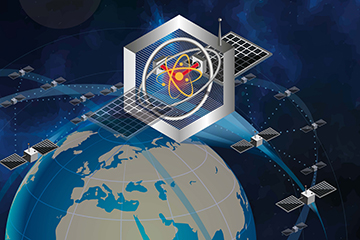![]()
[Image: Trumpf Group]
As the world relies more and more on spaceborne data communications—including, potentially, vast new fleets of miniature satellites in low-Earth orbit (LEO)—precise control of spacecraft positioning will be increasingly important to ensure a first-rate signal. A consortium of German companies and research institutes is now working on a project to create laser-based quantum gyroscopes to keep potentially errant satellites in line. The first satellites so equipped could be in space within five years, according to the team.
The consortium behind the new quantum-gyroscope project—a €28 million (US$28 million) undertaking dubbed QYRO—includes three industry members: the German engineering conglomerate Bosch; Trumpf Photonic Components, a subsidiary of the laser and machine-tools giant Trumpf Group; and the Stuttgart-based quantum technology startup Q.ant, a wholly owned subsidiary of Trumpf. These three companies will work with two other partners, the German Aerospace Center (DLR) and the Ferdinand Braun Institute, Leibniz Institute for High Frequency Technology.
Attitude-adjustment time
The specific task at hand relates to control of a spacecraft’s attitude—its 3D orientation in space. For conventional satellite-to-Earth communication, such position control is necessary to keep the spacecraft’s high-gain antenna pointed at the right spot on the planet’s surface; otherwise, the signal quality quickly starts to degrade. Careful control and pointing will become even more important as new fleets of satellites, targeting high-speed data communications, increasingly talk directly with each other using information carried on laser beams.
The QYRO team hopes to address the need for position control through a dose of quantum technology—which, according to the consortium, combines super-sensitive measurement with the potential for deployment in a lightweight, small package. The group thinks its solution, once developed, could “keep satellites correctly oriented in space over a period of years,” according to a Trumpf press release. But putting the pieces together, and getting the resulting quantum gyro qualified for the rigors spaceflight, will be no mean feat.
Spinning atoms

[Image: Trumpf Group]
In the design targeted by the consortium, tiny lasers will fire into a miniaturized measuring cell filled with an atomic gas, and will set those atoms to spinning in an applied magnetic field. Any rotation of the sensor cell with respect to the field will change the spin of the atoms. Those shifts will provide quick and highly precise feedback on wobbly attitude that can be fed into the satellite’s position-correction machinery.
Q.ant will act as the leader and system integrator in the project, and will also supply some key electronics, including what’s described as a “very low noise” detection system. Bosch, which launched a startup operation in quantum sensing in February 2022, will handle development of the sensor cell itself—which the company’s research director, Thomas Kropf, calls “the core component of the quantum sensor,” and which will be built on micro-electromechanical system (MEMS) technology.
The VCSEL difference
Trumpf, meanwhile, will handle the laser side of the setup. For this purpose, Trumpf Photonic Components, located in Ulm, will develop a 795-nm-wavelength, 10-mW vertical-cavity surface-emitting laser (VCSEL) light source—the same kind of tiny laser diode now found in smartphones, industrial sensors and many other applications. These small and durable lasers, the company says, were a natural choice for a compact sensor that needed to be ready for space travel. In developing the lasers for this particular job, Trumpf will also focus on stable polarization and very narrow bandwidth, to ensure the precision required for a quantum sensor.
Trumpf will team up in the VCSEL effort with the Ferdinand Braun Institute, to develop robust diode lasers with high spectral purity. Another Trumpf’s operation, in Berlin, will then work on integrating and packaging the lasers with control electronics and measurement technology. Once the lasers are fully integrated with the contributions from Bosch and Q.ant, DLR’s Galileo Competence Center will run the finished system through final tests for qualification in space. DLR will also be in charge of implementation, transportation and operation of the first QYRO-equipped satellite, targeted for launch in 2027.
Beyond satellite stability
Interestingly, the QYRO group is not the only one working on quantum gyroscopes for satellites. For example, QubeSat, a student-led technology demonstration at the University of California, Berkeley, USA, worked toward a test of a quantum gyroscope that used diamond nitrogen–vacancy centers rather than an atom-gas cell of the type QYRO is developing. The QubeSat quantum gyro was prepared and readied for launch in February 2022, but the payload never made it into space owing to a failure of the launch vehicle.
The QYRO project, meanwhile, sees itself as part of a larger project of “developing European quantum sensors … to achieve greater independence from the global market.” And while sensitive position sensors such as the quantum gyros destined for space might seem exotic, the consortium is quick to stress that the applications don’t stop with satellite-to-satellite communications. The same technology, according to the team, could also find use “for autonomous driving systems and indoor navigation technologies in factories, logistics warehouses and other facilities.”
“I can see a tremendously bright future for our miniature lasers in a whole variety of new applications,” Berthold Schmidt, the CEO of Trumpf Photonic Components, said in a company press release. “This is the kind of government-funded project that gives Germany a real boost as a major hub of photonics expertise.”
